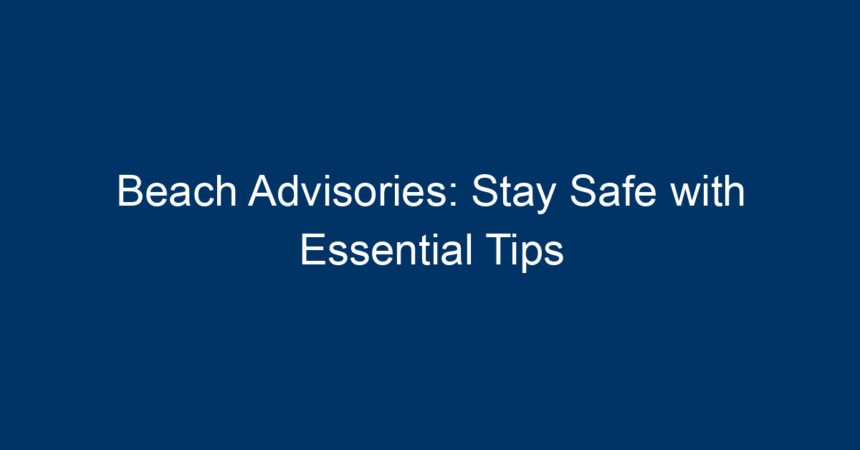As the warm sun beckons and the sound of waves calls out to beach lovers, the allure of sandy shores and relaxing tides can be irresistible. However, enjoying a day at the beach comes with its own set of challenges and safety concerns. This article dives deep into the importance of beach advisories, offering you essential tips to ensure that your seaside experience remains enjoyable and safe. By understanding beach advisories and staying informed about local conditions, you’ll not only enhance your beach experience but also protect your well-being.
Understanding Beach Advisories
What Are Beach Advisories?
Beach advisories are notifications issued by local authorities to inform the public about current conditions at the beach. These advisories can range from warning about water quality to alerting beachgoers about dangerous marine life, rip currents, or hazardous weather conditions. Staying informed about these advisories can significantly reduce risks while enhancing your enjoyment at the beach.
Why Are Beach Advisories Important?
Beach advisories play a vital role in ensuring public safety. They provide timely information that can prevent accidents, illness, and injuries. Ignoring these warnings can lead to serious health risks, even fatalities, especially in environments as unpredictable as the ocean. Understanding the significance of beach advisories can empower you to make informed choices before and during your beach visit.
Types of Beach Advisories
Water Quality Advisories
One of the most common types of beach advisories is related to water quality. Authorities issue these advisories when testing reveals unsafe levels of bacteria, algae, or other contaminants in the water. Swimming in contaminated water can lead to a range of health issues, including gastrointestinal diseases, skin rashes, and other infections.
Tips for Staying Informed:
- Check local health department websites before heading to the beach.
- Look for posted signs at the beach regarding water quality.
- Be wary of swimming near storm drains, as they can carry pollutants into the water.
Rip Current Advisories
Rip currents are powerful channels of water that flow away from the beach. Often difficult to identify, they pose a significant risk to swimmers. A rip current advisory warns beachgoers about the presence of these dangerous currents.
How to Identify and Respond to Rip Currents:
- Visual Indicators: Look for differences in water color, foam, or a gap in the wave pattern.
- Stay Calm: If caught in a rip current, remain calm, float, and signal for help. Swim parallel to the shore until free of the current, then swim back safely.
Marine Life Advisories
Certain beaches may experience periodic influxes of jellyfish, sharks, or other marine life that can pose risks to swimmers. When such occurrences are noted, marine life advisories are issued.
Precautionary Measures:
- Educate yourself about local marine life before visiting.
- Avoid swimming alone, especially during peak seasons for jellyfish or other potentially dangerous creatures.
- Observe local fisherman and other beachgoers; their caution may indicate high risks.
Weather Advisories
Weather conditions can change rapidly at the beach, making it crucial to stay updated on local forecasts. Severe weather advisories warn of storms, high winds, or extreme tides that could impact beach safety.
How to Prepare for Weather Changes:
- Check weather apps or local news outlets before your visit.
- Ensure everyone in your group understands the proper actions to take in the event of severe weather.
- Have a pre-planned escape route to safety.
Staying Safe at the Beach: Essential Tips
Plan Ahead
Before you head to the beach, know what to expect. Research the area, read up on current beach advisories, and familiarize yourself with any potential hazards. Planning your trip ahead of time can lead to a more enjoyable experience.
Arrive Early
Beach crowds can lead to misunderstandings about safety conditions. Arriving early allows you to assess the beach and check for posted warnings without the pressure of a busy environment.
Use Sun Protection
While not a traditional beach advisory, sun safety is crucial. Adverse effects from sun exposure can lead to sunburns, heat exhaustion, or worse. Always use broad-spectrum sunscreen with a high SPF, wear protective clothing, and reapply every couple of hours.
Stay Hydrated
It’s easy to forget to drink water while enjoying the beach. Dehydration can sneak up on you, especially under the sun. Bring plenty of water and take regular breaks to hydrate.
Swim Smart
Follow posted rules and swim only in designated areas supervised by lifeguards. Swimming near lifeguard stations can provide an added layer of safety, as these trained professionals monitor the waters and can respond quickly in emergencies.
Respect Nature
Understanding the natural environment is essential in ensuring safety. Observe the tides and currents, avoid disturbing wildlife, and refrain from touching unknown marine creatures. Remember that you are a guest in their habitat.
Conclusion: Be Beach-Wise
Being aware of beach advisories can be the difference between a fun day by the ocean and a potential disaster. By staying informed about water quality, rip currents, marine life, and weather conditions, you can significantly reduce your risk while maximizing your enjoyment.
As you prepare for your next beach excursion, consider these actionable insights:
- Check Local Advisories: Always look up beach conditions and advisories before leaving home.
- Pack Smart: Bring necessary gear, including sunscreen, water, and first aid supplies.
- Educate Others: Share safety tips with friends and family to ensure everyone understands the importance of adhering to beach advisories.
With the right preparation, you can enjoy the sun, surf, and sand while prioritizing safety. So grab your beach towels and sunscreen—knowing you’re beach-wise will help you create memories that last a lifetime!




